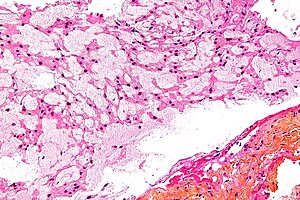Chordoma
Jump to navigation
Jump to search
Chordoma is an uncommon tumour in neuropathology.
| Chordoma | |
|---|---|
| Diagnosis in short | |
 Chordoma. HPS stain. | |
|
| |
| LM | physaliphorous cells (also bubble cells) - very large clear bubble with a sharp border, bubble does not compress nucleus; islands of cells surrounded by fibrous tissue; myxoid background |
| LM DDx | chondrosarcoma, myxoid lesions, parachordoma |
| IHC | S-100 +ve, AE1/AE3 +ve, Brachyury +ve, EMA +ve |
| Gross | myxoid |
| Site | sacrum or clivus |
|
| |
| Prevalence | uncommon |
General
- Location: usually sacrum or clivus.
- It is a bone tumour.
Gross
- Soft, gelatinous, lobulated.[1]
DDx:
- Bony metastasis (mucinous carcinoma) - typically multifocal.
Image:
Microscopic
Features:[2]
- Architecture: islands of cells surrounded by fibrous tissue.
- Also described as "lobulated" architecture; may not be apparent.
- Myxoid background - grey extracellular material, variable amount present.
- Mixed cell population:
- Abundant eosinophilic cytoplasm.
- Physaliphorous cells or bubble cells - key feature.
- Have a very large clear bubble with a sharp border; bubble does not compress nucleus - nucleus may be in bubble.
DDx:
- Chondrosarcoma.
- Myxoid lesions.
- Parachordoma - extremely rare.
Images
www:
IHC
See also
References
- ↑ URL: http://www.histopathology-india.net/Chordoma.htm. Accessed on: 12 April 2012.
- ↑ Tadrous, Paul.J. Diagnostic Criteria Handbook in Histopathology: A Surgical Pathology Vade Mecum (1st ed.). Wiley. pp. 184. ISBN 978-0470519035.
- ↑ URL: http://path.upmc.edu/cases/case312/micro.html. Accessed on: 14 January 2012.
- ↑ Coindre, JM.; Rivel, J.; Trojani, M.; De Mascarel, I.; De Mascarel, A. (Sep 1986). "Immunohistological study in chordomas.". J Pathol 150 (1): 61-3. doi:10.1002/path.1711500110. PMID 2431128.
- ↑ Online 'Mendelian Inheritance in Man' (OMIM) 601397
- ↑ URL: http://www.jstor.org/pss/86845. Accessed on: 18 May 2010.